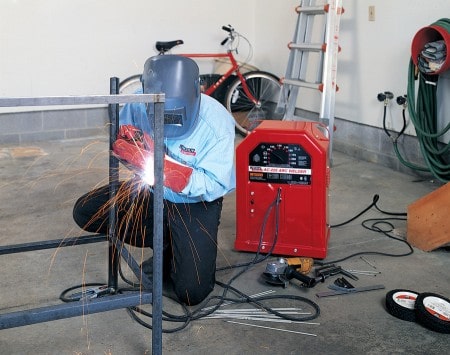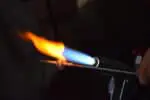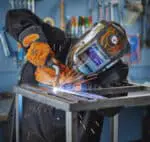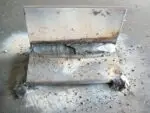Should Alternating Current or Direct Current be used when welding stainless steel? The answer is Direct Current, but it is the type of welding you’re doing that is fundamental.

DC is the most common type of current used in welding stainless steel. It is ideal for all types of maintenance and is usually the first choice for welding Steel. It also offers more than AC welding. The only exception to this may be the ship building industry which specifically works with Alternating Current.
In order to discuss which type of electrical current should be used when welding stainless steel, let’s take a look at both Alternating Current and Direct Current in welding.
Polarity and Welding
Welding is merely the procedure where various metals can be melted and a type of filler metal will be used to join or create a weld. The most frequently used and popular types of welding are:
-
-
- Arc welding that uses electrical current
- Gas welding
-
Not all metals will weld easily or correctly. Stainless steel, for example, may have a tendency to distort, warp or even crack. Various alloys may be difficult to navigate when welding if the exact chemical composition is unknown.
You will often hear the terms straight polarity and reverse polarity referred to in welding. “Straight polarity” means that the electrode is negative while “reverse polarity” indicates a positive electrode.
Welders, whether professionals or hobbyists need to understand exactly how polarity functions. In this way, one can select the correct electrode for the polarity in order to get the desired result.
Welding rods will be labeled so that you know which polarity must be used with a particular welding rod.
DC Welding
FIrstly, DC signifies “Direct Current”. This signifies that the electric charge always moves in a single direction and returns a constant polarity. When welding, two electrode connections exist, a direct current electrode positive and a direct current electrode negative.
The DCEN, or direct current electrode negative, also called straight current, will be quicker because the electrode’s melt-off is faster.
The straight current will also produce less heat than the reverse polarity of the DCEP (direct current electrode positive). For this reason, it is used more frequently on thinner metals exactly like stainless steel.
When using DC reverse polarity, where the electrode is positive, the current will flow from the metal you are working on to the electrode.
AC Welding
AC signifies Alternating Current and simply indicates that the electric charge will move in one direction half of the time that it is in use and move in the opposite direction during the other half of the time.
Reverse polarity or electrode positive can result in deeper penetration in and through metal. Some electrodes will need only one polarity while various other electrode shields will be able to work regardless of which polarity is used.
AC welding is fundamental, above all, and specifically for TIG high-frequency welding with aluminum but not for stainless steel.
See also: Is Welding Steel to Aluminium a Bad Idea
Incorrect Polarity Caused Problems
It is necessary to choose the correct polarity to get the best results from your welding. If you choose incorrectly your welding may suffer:
-
-
- Electrode burn out
- Lack of control of the arc
- Overheating
- Splatter
- Poor penetration
- Beading that is not uniform
-
Stainless Steel
To begin with, stainless steel is an alloy that is iron based with some percentage of chromium that may vary from approximately 11% to 30%.
The presence of chromium contributes to stainless steel’s resistance to rust. It is a sturdy metal that resists corrosion from chemicals, liquids, or gaseous sources.
As it also resists high temperatures, it is a common choice for tubes and pipes for the oil, restaurant, and medical industries. The only drawback may be that it is more costly than mild steel.
Stainless Steel Welding
Much will depend on what your objective is. Stainless steel can be welded using TIG, MIG, or stick welding processes, however, the result will vary. Things you should consider before choosing your stainless steel welding method include:
-
-
- Your level of welding expertise
- The desired aesthetic of your weld (In this case, TIG welding would give a more refined appearance.)
- The thickness of the stainless steel to weld
- The amount of time for the welding project (If you need speed, MIG will be a better alternative.)
- Cost
-
TIG Welding Stainless Steel
The most commonly used welding process when working with stainless steel is TIG welding. Since this welding process has a very low input of heat, it is ideal for thin material.
This is an important consideration because stainless steel will retain heat. If the welding temperature becomes too high, stainless steel can warp, even after welding during the process of cooling.
It is important to keep in mind that welding stainless steel can be unforgiving because it will show every mark, scratch, or blemish left after welding. This is not an ideal material for hiding any mistakes. TIG welding for stainless steel will employ Direct Current welding.
MIG Welding Stainless Steel
Stainless steel can be welded using MIG. The MIG procedure, unlike others, uses one standard type of voltage and one type of polarity. MIG welding uses Direct Current-voltage and requires Direct Current electrode positive.
MMA or Stick Welding for Stainless Steel
While this is the easiest procedure to set up as well as the most inexpensive, you will need to select the correct electrode for the weld. It is not a good choice for welding thin sheets of stainless steel.
Stick welding usually needs a high current but at low voltage. This welding process is polarity driven. It can be used but needs a Direct Current welder. Many inexpensive stick welders are generally Alternating Current, so keep this in mind if you want to use this welding process.
The Bottom Line
Most electrodes can be used for either Alternating Current and Direct Current welding and many welding machines will come with directions on how to change the polarity thanks to a switch or by changing cables.
The most common welding process used in welding stainless steel is TIG while stainless steel welding is performed with Direct Current.







